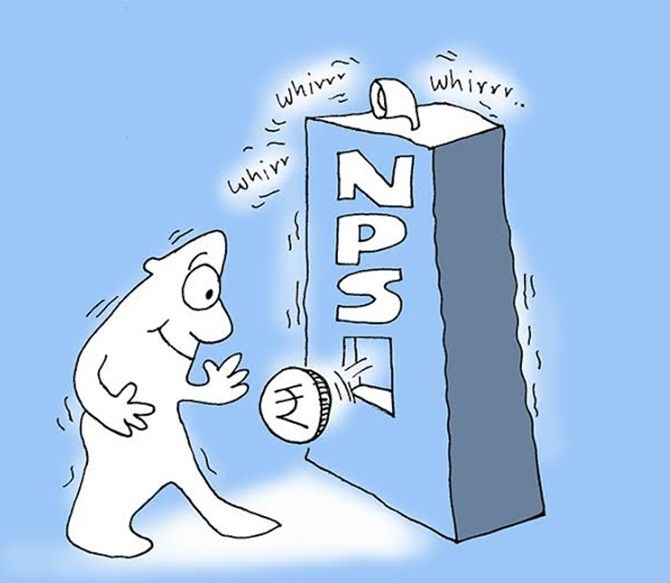Raise in NPS entry age gives seniors another retirement-saving option but they should invest at least Rs 50,000 to avail of the additional tax benefit the scheme provides, reports Sanjay Kumar Singh.
Illustration: Uttam Ghosh/Rediff.com

The Pension Fund Regulatory and Development Authority (PFRDA) has raised the age of entry into the National Pension System (NPS) for the private sector from 60 to 65.
For those who did not join the NPS earlier but would like to do so after 60, this is a positive step.
In its circular, PFRDA says it hiked the entry age in response to requests from the public, corporates and intermediaries.
With better healthcare facilities, growing fitness levels, and increasing lifespans, more people now work after 60, and hence have the ability to contribute to a retirement-saving product such as NPS.
"It gives people, who may not have saved enough for their retirement, one more product option," says Mumbai-based financial planner Arnav Pandya.
Those who join NPS after 60 will be able to invest until 70.
According to Arvind A Rao, financial planner and founder, Arvind Rao & Associates, "NPS gives you an additional tax advantage of Rs 50,000. By increasing the entry age, PFRDA has allowed senior citizens to start after 60 and get that advantage for another 10 years."
Another advantage of investing in NPS till a later age is that the return you get on an annuity is higher when you buy it at a more advanced age.
The same investment choices will be available to such a person as to those who join earlier. The asset allocation in the life-cycle fund will be the same as is applicable to subscribers beyond the age of 55.
Those who have accumulated enough for retirement need not join NPS.
"The disadvantage of NPS is that the individual cannot withdraw the entire corpus as lump sum. Forty per cent has to be compulsorily annuitised and returns from annuities are not high. Also, the tax impact can eat away a part of the corpus since only 40 per cent of the accumulated amount is tax-free," says Pandya.
According to Rao, "Due to the compulsion to annuitise, most people prefer to invest in NPS only up to Rs 50,000. They prefer to save for retirement through other instruments where they don't have to annuitise."
The PFRDA circular also spells out the exit options for those who join after 60. One, they may exit after three years. This will be treated as a normal exit: 40 per cent of the corpus will be annuitised and 60 per cent will be paid as lump sum.
"The low lock-in of three years is a positive since several other products for senior citizens come with a five-year lock-in," says Rao.
He adds that most senior citizens who work after 60 don't get long-term work contracts. The typical contract is of one year.
"A long lock-in can cause hardships if their contract is not renewed," says Rao.
If the corpus at the time of exit is less than or equal to Rs 2 lakh, the subscriber will have the option to withdraw the entire amount (and not buy an annuity at all).
Two, if a person exits before the completion of three years, this will be treated as a premature exit. The subscriber will then be required to annuitise at least 80 per cent of his corpus.
If the accumulated corpus is less than or equal to Rs 1 lakh, he will have the option to get the entire corpus as a lump sum.
Three, if the subscriber passes away, the entire corpus will be handed over to the nominee.












 © 2025
© 2025